200th anniversary of the death of Leonhard Euler - Germany / German Democratic Republic 1983 - 20 Pfennig
Theme: Astronomy & Space
| Country | Germany / German Democratic Republic |
| Issue Date | 1983 |
| Face Value | 20.00 |
| Color | blue |
| Perforation | K 13:12 1/2 |
| Printing Type | offset |
| Stamp Type | Postage stamp |
| Item Type | Stamp |
| Chronological Issue Number | 2567 |
| Chronological Chapter | GER-DDR |
| SID | 287637 |
| In 16 Wishlists | |
On the 200th anniversary of the death of Leonhard Euler On the 200th anniversary of the death of Leonhard Euler, the Ministry of Posts and Telecommunications of the German Democratic Republic issues a special postage stamp. Special cancellation from September 6 to November 5, 1983 Leonhard Euler On November 18, 1983, the 200th anniversary of the death of Leonhard Euler. Euler, born on April 15, 1707 in Basel, was the most important mathematician between Newton and Gauss and certainly one of the most prolific mathematicians of all time. Euler, born in Switzerland, moved to Petersburg at the age of 20, where he lived and worked until 1741 and from 1766 until his death. From July 25, 1741 to June 9, 1766, he spent 25 years of fruitful work in Berlin. In 1741 he took over the direction of the observatory. In the same year the scholar became a member of the Berlin Academy - today's Academy of Sciences of the GDR - and director of the mathematical class. Leonhard Euler completed 380 works in Berlin. Euler 's importance lies in the versatility with which he enriched the most diverse fields of mathematics, from number theory to the theory of series, from analysis to differential geometry, from algebra to the theory of functions, with some disciplines such as the calculus of variations and the hydrodynamics - only scientifically justified. The application of mathematics to astronomical, mechanical, optical, cartographic, ballistic, shipbuilding, technological and music theory problems showed his connection with practice. These included such tasks as the leveling of the Finow Canal, the creation of water features in Sanssouci and appraisals in financial matters for the Prussian king. Through his textbooks, he decisively influenced the further development of mathematical teaching and research. Euler's textbooks, for example, have shaped the mathematics of engineering well into our century. Thanks to Euler's relations, there were close contacts between the academies in Berlin and Petersburg, so that from Berlin he also promoted young Russian scientists, among them M. W. Lomonosov. In addition to the portrait of L. Euler, the special postage stamp depicts the Eulerian polyhedron substitute and, as an example of an Eulerian polyhedron, an icosahedron, a regular twenty-facet calculator. Polyhedra or planar surfaces are those bodies that are bounded by flat surfaces (cube, prism, pyramid ...). A polyhedron is called a convex or an Eulerian polyhedron if the link of any two of its points contains only points from inside the polyhedron. The Euler polyhedron is: If e is the number of vertices, f is the number of faces, and k is the number of edges, then for a convex polyhedron e - k + f = 2.


